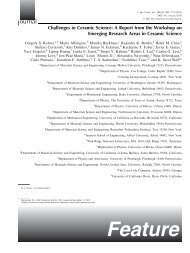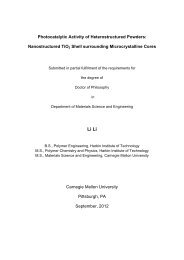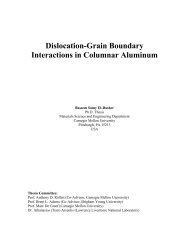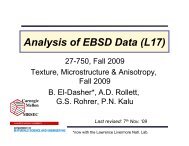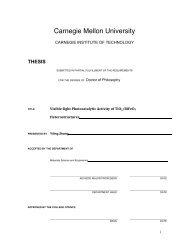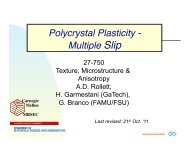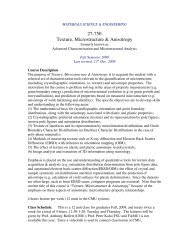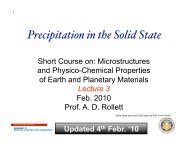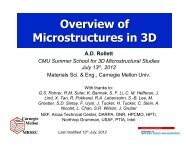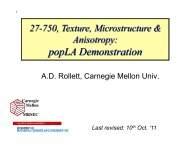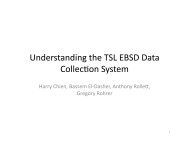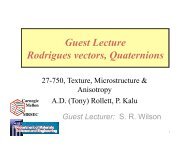¶ 3. Mathematical Representation of Crystal Orientation, Misorientation
¶ 3. Mathematical Representation of Crystal Orientation, Misorientation
¶ 3. Mathematical Representation of Crystal Orientation, Misorientation
Create successful ePaper yourself
Turn your PDF publications into a flip-book with our unique Google optimized e-Paper software.
The associated (110) pole figure is very similar to the Goss texture pole figure except that<br />
it is rotated about the ND. In this example, the crystal has been rotated in only one sense<br />
(anticlockwise).<br />
Fig. Gii.6. Schematic {001}, {111} and {110} pole figures, reading from left to right, for<br />
the Brass component. The RD is vertical in these diagrams and the TD horizontal. Only<br />
one variant <strong>of</strong> the Brass component is shown or clarity; the other variant (related by<br />
sample symmetry) can be obtained by a rotation <strong>of</strong> 70° about the ND (for example).<br />
The brass component is convenient because we can think about performing two<br />
successive rotations:<br />
1st about the ND, 2nd about the new position <strong>of</strong> the [100] axis.<br />
1st rotation is 35° about the ND; 2nd rotation is 45° about the [100].<br />
(φ 1, Φ, φ 2) = ( 35°, 45° , 0° ).<br />
The existence <strong>of</strong> variants <strong>of</strong> a given texture component is a consequence <strong>of</strong> (statistical)<br />
sample symmetry. If one permutes the Miller indices for a given component (for cubic<br />
materials, one can change the sign and order, but not the set <strong>of</strong> digits), then different<br />
values <strong>of</strong> the Euler angles are found for each permutation. If a pole figure is plotted <strong>of</strong> all<br />
the variants, one observes a number <strong>of</strong> physically distinct orientations, which are related<br />
to each other by symmetry operators (diads, typically) fixed in the sample frame <strong>of</strong><br />
reference. Each physically distinct orientation is a “variant”. The number <strong>of</strong> variants<br />
listed depends on the choice <strong>of</strong> size <strong>of</strong> Euler space and the alignment <strong>of</strong> the component<br />
with respect to the sample symmetry. A typical size <strong>of</strong> Euler space is 90x90x90°; this is<br />
appropriate to a combination <strong>of</strong> cubic crystal symmetry and orthorhombic sample<br />
symmetry. The space contains three copies, however, <strong>of</strong> the fundamental zone, which<br />
leads to considerable potential for confusion, as will be discussed in detail below.<br />
<strong>3.</strong>H Fundamental Zones: Summary<br />
What is a “fundamental zone” or “irreducible space”? It is a set <strong>of</strong> physically distinct<br />
orientations (or misorientations) and it is intimately linked to symmetry, both in the<br />
crystal and in the sample. This approach illustrates that it is linked to representation <strong>of</strong><br />
physical objects, whether grains or grain boundaries (or interfaces….). In terms <strong>of</strong> the<br />
mathematical representation, it is the range <strong>of</strong> the parameters the delineates the zone. In<br />
graphical terms, it is the smallest region <strong>of</strong> the parameter space that encloses all <strong>of</strong> the<br />
8/27/09 24



